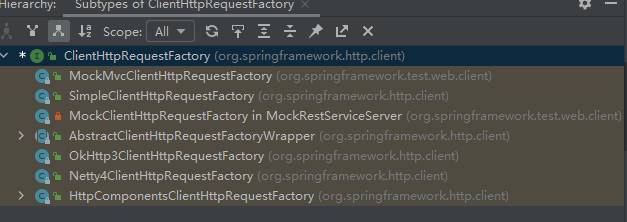RestTemplate
YuWei Wu 2/12/2022 Javainternet
RestTemplete是一个同步Web Http客户端请求模板工具
# 常用API
| Method group | Description |
|---|---|
getForObject | Retrieves a representation via GET. |
getForEntity | Retrieves a ResponseEntity (that is, status, headers, and body) by using GET. |
headForHeaders | Retrieves all headers for a resource by using HEAD. |
postForLocation | Creates a new resource by using POST and returns the Location header from the response. |
postForObject | Creates a new resource by using POST and returns the representation from the response. |
postForEntity | Creates a new resource by using POST and returns the representation from the response. |
put | Creates or updates a resource by using PUT. |
patchForObject | Updates a resource by using PATCH and returns the representation from the response. Note that the JDK HttpURLConnection does not support PATCH, but Apache HttpComponents and others do. |
delete | Deletes the resources at the specified URI by using DELETE. |
optionsForAllow | Retrieves allowed HTTP methods for a resource by using ALLOW. |
exchange | More generalized (and less opinionated) version of the preceding methods that provides extra flexibility when needed. It accepts a RequestEntity (including HTTP method, URL, headers, and body as input) and returns a ResponseEntity.These methods allow the use of ParameterizedTypeReference instead of Class to specify a response type with generics. |
execute | The most generalized way to perform a request, with full control over request preparation and response extraction through callback interfaces. |
# 初始化
常见的Http客户端工具有
- JDK HttpURLConnenction
- Apache HttpComponents
- Okttp
- Netty
而RestTemplete都是基于以上客户端工具的进一步封装
初始化:
- 默认构造器使用的是java.net.HttpURLConnection
RestTemplate restTemplate = new RestTemplate();
- 可以在构造器中创建实现ClientHttpRequestFactory接口的实现类

比如想用Apache HttpComponents 作为底层执行引擎
RestTemplate template = new RestTemplate(new HttpComponentsClientHttpRequestFactory());
配置类:
package com.example.demo.config;
import org.springframework.context.annotation.Bean;
import org.springframework.context.annotation.Configuration;
import org.springframework.web.client.RestTemplate;
@Configuration
public class RestConfig {
@Bean
public RestTemplate restTemplate(){
return new RestTemplate();
}
}
# 使用
# Get请求
getForObject获得Get请求到的返回值
所需要的相关参数

使用案例:
package com.example.demo.controller;
import org.springframework.beans.factory.annotation.Autowired;
import org.springframework.web.bind.annotation.RequestMapping;
import org.springframework.web.bind.annotation.RequestMethod;
import org.springframework.web.bind.annotation.RestController;
import org.springframework.web.client.RestTemplate;
import java.util.Collections;
import java.util.HashMap;
@RestController
public class GetController {
@Autowired
RestTemplate restTemplate;
@RequestMapping(value = "/get/object",method = RequestMethod.GET)
public String getForObject(){
String url = "http://localhost:8089/test01/{username}/{userage}";
HashMap<String,String> params = new HashMap();
params.put("username","zhangsan");
params.put("userage","12");
//1.采用hashMap进行封装参数
return restTemplate.getForObject(url,String.class,params);
//2.直接传参数
// return restTemplate.getForObject(url,String.class,"zhangsan","13");
}
}
//RestTemplate请求的接口
@RequestMapping(value = "test01/{username}/{userage}",method = RequestMethod.GET)
public String test01(@PathVariable("username") String username,
@PathVariable("userage") String userage){
return "姓名:"+username+" "+"年龄:"+userage;
}
getForEntity获取详细报文包括状态码,返回体,返回头等
所需要的相关参数

使用案例:
@RequestMapping(value = "/get/entity",method = RequestMethod.GET)
public String getForEntity(){
String url = "http://localhost:8089/test01/{username}/{userage}";
HashMap<String,String> params = new HashMap();
params.put("username","zhangsan");
params.put("userage","12");
ResponseEntity<String> forEntity = restTemplate.getForEntity(url, String.class, params);
HttpStatus statusCode = forEntity.getStatusCode();
System.out.println("状态码值:"+statusCode);
int statusCodeValue = forEntity.getStatusCodeValue();
System.out.println("状态码:"+statusCodeValue);
HttpHeaders headers = forEntity.getHeaders();
System.out.println("返回头:"+headers);
String body = forEntity.getBody();
System.out.println("返回体:"+body);
return body;
}
返回结果:
2022-02-10 22:25:53.161 INFO 20552 --- [nio-8089-exec-1] o.a.c.c.C.[Tomcat].[localhost].[/] : Initializing Spring DispatcherServlet 'dispatcherServlet'
2022-02-10 22:25:53.161 INFO 20552 --- [nio-8089-exec-1] o.s.web.servlet.DispatcherServlet : Initializing Servlet 'dispatcherServlet'
2022-02-10 22:25:53.162 INFO 20552 --- [nio-8089-exec-1] o.s.web.servlet.DispatcherServlet : Completed initialization in 1 ms
状态码值:200 OK
状态码:200
返回头:[Content-Type:"text/plain;charset=UTF-8", Content-Length:"29", Date:"Thu, 10 Feb 2022 14:25:53 GMT", Keep-Alive:"timeout=60", Connection:"keep-alive"]
返回体:姓名:zhangsan 年龄:12
# Post请求
- postForObject获得Post请求传来的返回值
所需参数与之前的GetForObject有一定的出入,传入值与转换类型泛型类位置是颠倒的;

情景一:服务商接受参数没有@RequestBody
@PostMapping("test03")
public String test03(UserDto userDto){
return "姓名:"+userDto.getUsername()+" "+"ID:"+userDto.getUserId();
}
@GetMapping("post/object")
public String postForObject(){
//如果服务商直接接受参数或者包装类的话
//必须要使用MultiValueMap,否则无法完成传输 ******特别注意******
String url = "http://localhost:8089/test03/";
MultiValueMap<String, String> map = new LinkedMultiValueMap<>();
map.add("userId","1000");
map.add("username","Lisi");
return restTemplate.postForObject(url, map, String.class);
}
情景二:服务商请求参数含有@RequestBody
@RequestHeader HttpHeaders headers 非必须,但是可以获取请求头相关参数。
@PostMapping("test02")
public String test02(@RequestBody UserDto userDto, @RequestHeader HttpHeaders headers){
System.out.println(headers.getAccept());
return "姓名:"+userDto.getUsername()+" "+"ID:"+userDto.getUserId();
}
- 方式一:HashMap传递参数
@GetMapping("post/object1")
public String postForObject1(){
//如果服务商采用RequestBody进行接收
//必须要使用HashMap,否则无法完成传输
String url = "http://localhost:8089/test02/";
HashMap<String, String> map = new HashMap<>();
map.put("userId","1000");
map.put("username","Lisi");
return restTemplate.postForObject(url, map, String.class);
}
- 方式二:通过包装HttpEntity进行与服务端交互(推荐)
@GetMapping("post/object2")
public String postForObject2(){
//如果服务商采用RequestBody进行接收
//同时也可以采用这种方式(推荐)
//申明请求头
HttpHeaders httpHeaders = new HttpHeaders();
httpHeaders.setContentType(MediaType.APPLICATION_JSON);
String url = "http://localhost:8089/test02/";
UserDto userDto = new UserDto();
userDto.setUserId("10086");
userDto.setUsername("王五");
//HttpEntity包装
HttpEntity<UserDto> userDtoHttpEntity = new HttpEntity<>(userDto, httpHeaders);
return restTemplate.postForObject(url, userDtoHttpEntity, String.class);
}
- postForEntity获取详细信息
两种情况与postForObject一致
@GetMapping("post/entity")
public String postForEntity(){
//申明请求头
HttpHeaders httpHeaders = new HttpHeaders();
httpHeaders.setContentType(MediaType.APPLICATION_JSON);
String url = "http://localhost:8089/test02/";
UserDto userDto = new UserDto();
userDto.setUserId("10086");
userDto.setUsername("王五");
//HttpEntity包装
HttpEntity<UserDto> userDtoHttpEntity = new HttpEntity<>(userDto, httpHeaders);
ResponseEntity<String> stringResponseEntity = restTemplate.postForEntity(url, userDtoHttpEntity, String.class);
String body = stringResponseEntity.getBody();
return body;
}
# exchange方式
这种方式可以看成是对Get与Post整个方法的一个整合,只需要在restTemplate.exchange()中指定是Get或者是Post请求即可。
package com.example.demo.controller;
import com.example.demo.dto.UserDto;
import org.springframework.beans.factory.annotation.Autowired;
import org.springframework.http.*;
import org.springframework.web.bind.annotation.GetMapping;
import org.springframework.web.bind.annotation.RestController;
import org.springframework.web.client.RestTemplate;
@RestController
public class ExchangeController {
@Autowired
RestTemplate restTemplate;
@GetMapping("post/change")
public String postForEntity(){
//申明请求头
HttpHeaders httpHeaders = new HttpHeaders();
httpHeaders.setContentType(MediaType.APPLICATION_JSON);
String url = "http://localhost:8089/test02/";
UserDto userDto = new UserDto();
userDto.setUserId("10086");
userDto.setUsername("王五");
//HttpEntity包装
HttpEntity<UserDto> userDtoHttpEntity = new HttpEntity<>(userDto, httpHeaders);
ResponseEntity<String> stringResponseEntity = restTemplate.exchange(url, HttpMethod.POST,userDtoHttpEntity, String.class);
String body = stringResponseEntity.getBody();
return body;
}
}
